|
|
|
Sort Order |
|
|
|
Items / Page
|
|
|
|
|
|
|
| Srl | Item |
| 1 |
ID:
192300


|
|
|
|
|
| Summary/Abstract |
Building on anthropological developments in the study of the state that highlight its margins, informal connections, and everyday dynamics, this paper examines the diverse strategies that Tanchangya villagers employ while negotiating peace and ‘development’ processes with local state actors in the Chittagong Hill Tracts (CHT), Bangladesh. It shows that the state is manifested in various forms at the local level. In a myriad of forms of encounters with state actors, Tanchangya villagers employ situated strategies of avoidance, engagement, and resistance. The paper claims that these strategies ultimately contribute to challenge the dominant processes that confine Tanchangya villagers to a state of marginalisation, and aim to aid in the struggle to create greater spaces for the social, economic, and political dimensions of their lives. Thus, this paper offers an analysis of micro-power struggles that take place in the CHT’s rural spaces vis-à-vis the complex matrix of peace, citizenship, and ‘development’ in the region.
|
|
|
|
|
|
|
|
|
|
|
|
|
|
|
|
| 2 |
ID:
149257
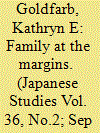

|
|
|
| 3 |
ID:
090163
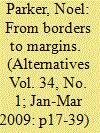

|
|
|
|
|
| Publication |
2009.
|
| Summary/Abstract |
While concepts of a postinternational politics properly highlight the constant variance of entities in play in international relations, the approach lacks an ontology that shows how such an unstable variety of types of players can coexist in a common field in the first place. This article draws upon Deleuze's philosophy to set out an ontology in which the continual reformulation of entities in play in "postinternational" society can be grasped. This entails a strategic shift from speaking about the "borders" between sovereign states to referring instead to the "margins" between a plethora of entities that are ever open to modifications of identity. The concept of the margin possesses a much wider reach than borders, and focuses continual attention on the meetings and interactions between a range of indeterminate entities whose interactions may determine both themselves and the types of entity that are in play.
|
|
|
|
|
|
|
|
|
|
|
|
|
|
|
|
| 4 |
ID:
107219
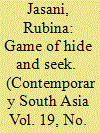

|
|
|
|
|
| Publication |
2011.
|
| Summary/Abstract |
This paper analyses the gendered experience of the state for the Muslim survivors of violence in Gujarat in 2002. Most of the scholarship on the working of the state after communal violence in post-independence India concentrates on the anxiety to re-instate the 'myth of the state', through policies that establish its respectability after violence. The emphasis is on understanding the mechanics of the state, its 'order making' function. Very little attention has been paid to understanding the lived experience of the modern state from a gendered perspective. What studies there have been tend to focus on the internal power structures within nationalist discourses, the patriarchal nature of state assertion, and point to forgotten narratives within the meta-narratives of violence and suffering. There is very little evidence examining how men and women experienced the same process differently, or how they make sense of their experiences, in a context where the lines between order and chaos, legitimacy and illegitimacy and trust and betrayal were constantly being redrawn. In examining memories of loss and suffering, this paper shows the contrasting and shifting ways in which the state is experienced, imagined and granted legitimacy by men and women from the margins.
|
|
|
|
|
|
|
|
|
|
|
|
|
|
|
|
| 5 |
ID:
083745
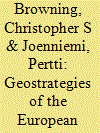

|
|
|
|
|
| Publication |
2008.
|
| Summary/Abstract |
The debate about the European Neighbourhood Policy (ENP) has, in essence, been about borders and bordering. Such departures could contribute - and often do so - to a rather fixed geopolitical vision of what the EU is about and how it aims to run and to organize the broader European space. However, this article aims to retain space for viewing the ENP as a developmental and somewhat fluid process. A conceptual framework, based on outlining three geopolitical models and a series of different geopolitical strategies employed by the EU in regard to its borders, is hence employed in order to be able to tell a more dynamic story regarding the developing nature of the ENP and the EU's evolving nature more generally. The complexity traced informs us that various geostrategies may be held at the same time at the external border. Moreover, the dominance of one geostrategy may be replaced by another or a different combination of them with regard to the same neighbourhood. It is, more generally, argued that if anything it is precisely this dynamism that should be championed as a valuable resource, avoiding the tendency to close off options through the reification of particular visions of the nature of the EU and its borders.
|
|
|
|
|
|
|
|
|
|
|
|
|
|
|
|
| 6 |
ID:
159926
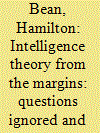

|
|
|
|
|
| Summary/Abstract |
This article explores post-2009 contributions to intelligence theorizing that focus on critique and transformation of dominant IS ontologies and epistemologies. This exploration illuminates diverse theoretical resources that can help reveal hidden or misunderstood intelligence-related phenomena. The article contributes to recent calls for establishing a Critical Intelligence Studies subfield that attempts to move associated scholarship from the margins of Intelligence Studies to a more visible and influential position within the field.
|
|
|
|
|
|
|
|
|
|
|
|
|
|
|
|
| 7 |
ID:
148951
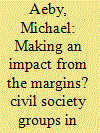

|
|
|
|
|
| Summary/Abstract |
The paper examines the role of civil society organisations (CSOs) in Zimbabwe's interim power-sharing process. It identifies CSOs’ organisational capacity, nature of engagement in the political process and relations with the power-sharing parties as the principal issues affecting CSOs’ ability to promote peace-making and democratisation in the context of a transitional executive power-sharing process. Based on these analytical themes, the case analysis argues that CSOs’ sway on the transition was particularly constrained by organisational fragmentation and disunity, divergent strategies vis-à-vis the interregnum, diminishing access to political elites, the latter's refusal to permit greater civic involvement, and continued repression.
|
|
|
|
|
|
|
|
|
|
|
|
|
|
|
|
| 8 |
ID:
164423
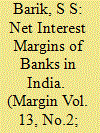

|
|
|
|
|
| Summary/Abstract |
Net interest margin (NIM) is the raison d’être of banking. It is an important measure of efficacy of the banking sector. At the system level, it is indicative of the cost of financial intermediation, health of the banking sector and its pricing power. In recent years, the Indian banking sector has experienced a major metamorphosis, with increasing competition and changing norms of liquidity, income recognition and capital. The end of regulatory forbearance and asset quality review (AQR) unearthed significant non-performing assets. This article traces the influence of various factors on the NIM, using bank-level data for 42 Indian banks over 25 quarters from March 2011 to March 2017. The study employs a dynamic panel generalised method of moments (GMM) framework to trace the impact of three distinct set of factors in setting banks’ NIMs: bank-level factors (like the share of low interest-bearing deposits held, the extent of gross non-performing assets [GNPAs], the capital-to-risk weighted assets ratio [CRAR], size of the loan book, operating costs and lending rates); system-level factors such as the monetary policy rate, credit growth and yields on government securities and macro-variables such as GDP growth and inflation. The results indicate that the main determinants of NIMs are banks’ CRAR levels, the proportion of current account and savings account deposits (CASA) to total deposits, operating costs and size of the loan book. Macro-factors like the growth of the economy and repo rate have a positive influence on the NIM.
|
|
|
|
|
|
|
|
|
|
|
|
|
|
|
|
| 9 |
ID:
149480
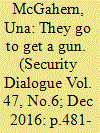

|
|
|
|
|
| Summary/Abstract |
This article examines rumour as a distinct type of speech act and makes a case for engaging with the spaces within which rumours are deployed and circulated in practice. Critiquing the rigid linguistic focus on speech acts within prevailing securitization theories, it follows insights from the fields of political geography and anthropology in order to incorporate voices from the margins more fully into its analysis of threat construction. Examining the local deployment and circulation of rumours in religiously mixed Arab localities in Israel, it argues that the perlocutionary force of rumour not only is rooted in local security and policing arrangements but reveals a spatialization of violence that is particular to the margins. In so doing, the article seeks to contribute to a broadening of the research agenda on the social construction of threat that would not only bring ‘security have-nots’ to the centre of its analysis but draw attention to the margins as a particular type of security space.
|
|
|
|
|
|
|
|
|
|
|
|
|
|
|
|
|
|
|
|
|